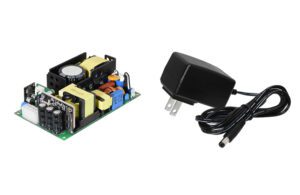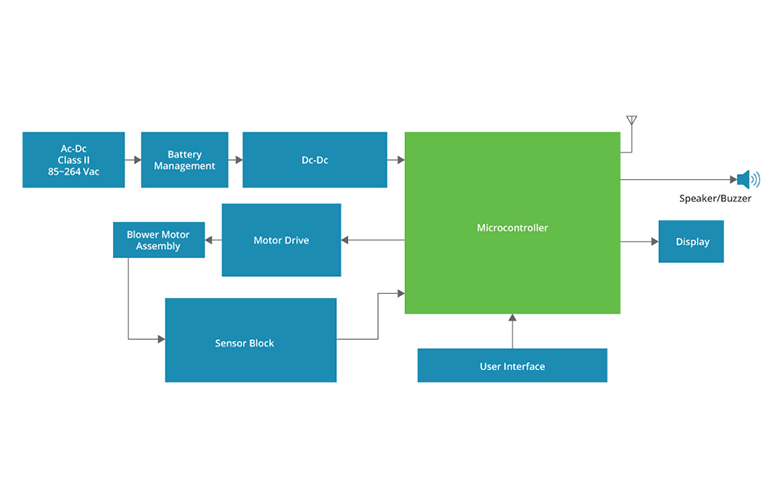
Internal medical ac/dc power supplies and external medical ac/dc power supplies have 60601-1 certification for 2 x MOPP (means of patient protection). [Photo courtesy of CUI]
Patients using blood pressure monitors and CPAP devices in non-clinical environments are protected by IEC 60601-1-11.
Ron Stull, CUI
Home medical devices can provide an excellent first line of defense when dealing with health and medical issues, and there is an increased need for at-home care for patients released from hospitals and other healthcare facilities.
The medical technologies used in nonclinical environments range in complexity from simple materials for administering first aid to sophisticated devices for delivering advanced treatment.
Complex at-home electrical medical devices must comply with the stringent IEC 60601-1 safety standards for medical patient protection. They must also adhere to additional requirements related to risks found in and around the home, like untrained equipment users and the uncontrolled at-home environment.
Blood pressure measurements
Blood pressure is a critical vital sign guiding acute and long-term clinical decision-making. Generally, blood pressure measurement collects systolic pressure and diastolic pressure.
Systolic pressure is the peak arterial pressure during systole, when the heart muscle pumps blood from the chambers into the arteries. Diastolic pressure is the minimum arterial pressure during diastole, when the heart muscle relaxes and fills the chambers with blood.
Mean arterial pressure (MAP) is calculated from systolic pressure (SP), diastolic pressure (DP) and pulse pressure (PP) using the following equations: MAP = DP + 1/3 (SP – DP), or MAP = DP + 1/3 (PP).
A pressure sensor measures the patient’s systolic and diastolic pressures as the cuff deflates. For example, an ac-powered, wheelchair-accessible blood pressure measurement device has a cuff and elbow sensor inside the unit that automatically adjusts to ensure the patient is in the correct position for highly accurate results every time.
The blood pressure measurement system requires an ac/dc power supply that complies with the medical IEC 60601-1 electrical safety requirements and meets the requirements for home use laid out in the IEC 60601-1-11 collateral standard. An internal ac/dc power supply series or an external series of wall-plug adapters address those medical at-home power requirements and safety concerns.
IEC 60601-1-11 compliance requires that power supplies be rated with IEC protection Class II due to an assumption that the electrical environment has a poor protective earth conductor or none. Class II power supplies provide the proper level of protection without relying on protective earth ground by applying double or reinforced insulation.
CPAP systems
The gold standard for obstructive sleep apnea (OSA) devices is the continuous positive airway pressure (CPAP). The ac-powered CPAP device provides consistent air support for night-time breathing difficulties like apneas, hypopneas and snoring. The machine connects directly to the patient in medical, clinic, hospital, or at-home environments.
Automatic CPAP features are essential due the expected use by untrained operators. The device reacts to the patient’s breathing breath-by-breath and the machine’s reading of these reactions eliminates the need to adjust settings by at-home healthcare operators. In addition, the CPAP machine offers climate control, which automatically adjusts humidity and temperature of the delivered air. Humidity and temperature measurements provide optimum comfort and protect the patient from condensation in the mask and tubing.
The at-home environment may contain a variety of electromagnetic noise emitting devices that could interfere with the functioning of medical equipment and sensors. Home medical devices must meet stricter requirements than traditional medical equipment to limit potential interference their own emissions. For example, traditional medical equipment must meet CISPR 11 class A emissions, while home medical equipment must meet the stricter class B limits.
CPAP machines can use cellular, Bluetooth Low Energy or Wi-Fi connections to upload data to a cloud service, but reliable communication requires minimal interference. Wireless CPAP device connectivity also enables telehealth/telemedicine help to address common CPAP performance issues like lack of comfort and usage difficulties. The CPAP device requires a power connection that meets the medical IEC 60601-1-11 safety standard. CPAP devices with wall power use an isolated ac/dc power supply complying with IEC 60601-1-11 standard.
Some portable CPAP devices run on battery power while traveling. The CPAP system and other portable medical devices must meet harsher shock and vibration tests, and some added mechanical stress tests. With battery power, the ac/dc battery charger configuration still requires a connection that complies with the medical IEC 60601-1-11 safety standard.
The IEC 60601-1 isolated ac/dc power must allow for a +10/-15% mains supply variation to account for the less predictable residential power infrastructure. This means an input range of 85 to 264 Vac for universal operation.
The motor and sensor systems are underneath the battery charger and the non-isolated dc/dc power structure. The motor system has a blower assembly that pushes air in the nasal mask tubing. The sensor system uses several sensors to measure humidity, temperature and nasal mask flow.

Electrical topology of a CPAP device, containing power, sensors, fan motor, and patient interface [Illustration by CUI]
Conclusion
Electronic home medical devices monitor and evaluate an individual’s health and provide data for early diagnostic and future treatment guidance. This article used the examples of electric-powered blood pressure and CPAP systems with the IEC 60601-1 power supply backbone and sensing technologies to demonstrate home diagnostic electric equipment. Due to the differences between the home and hospital, home medical devices must meet IEC 60601-1-11 safety requirements.

Ron Stull, power product marketing engineer at CUI [Photo courtesy of CUI]
Ron Stull, power product marketing engineer at CUI, is an experienced engineer with knowledge and experience in analog power, digital power and ac/dc and dc/dc power conversion. He joined CUI in 2009 and has served in key roles across different facets of engineering (including application support), test and validation, and design.
The opinions expressed in this post are the author’s only and do not necessarily reflect those of MedicalDesignandOutsourcing.com or its employees.